
Huntington Station is a hamlet and census-designated place (CDP) in the Town of Huntington in Suffolk County, on Long Island, in New York. The population was 33,029 at the 2010 census.

Connetquot River State Park Preserve is a 3,473-acre (14.05 km2) state park and conservation area in the Town of Islip in Suffolk County, New York in the United States. The park contains the Long Island Environmental Interpretive Center as well as the Southside Sportsmens Club District, which was listed on the National Register of Historic Places in 1973.

The House of the Seven Gables is a 1668 colonial mansion in Salem, Massachusetts, named for its gables. It was made famous by Nathaniel Hawthorne's 1851 novel The House of the Seven Gables. The house is now a non-profit museum, with an admission fee charged for tours, as well as an active settlement house with programs for children. It was built for Captain John Turner by Samuel Wardwell and stayed with the family for three generations.
The New York State Office of Parks, Recreation and Historic Preservation (NYS OPRHP) is a state agency within the New York State Executive Department charged with the operation of state parks and historic sites within the U.S. state of New York. As of 2014, the NYS OPRHP manages nearly 335,000 acres of public lands and facilities, including 180 state parks and 35 historic sites, that are visited by over 78 million visitors each year.

The Eugene O'Neill National Historic Site, located in Danville, California, preserves Tao House, the Monterey Colonial hillside home of America's only Nobel Prize-winning playwright, Eugene O'Neill.

Sunnyside (1835) is a historic house on 10 acres along the Hudson River, in Tarrytown, New York. It was the home of the American author Washington Irving, best known for his short stories, such as "Rip Van Winkle" (1819) and "The Legend of Sleepy Hollow" (1820).

"When Lilacs Last in the Dooryard Bloom'd" is a long poem written by American poet Walt Whitman (1819–1892) as an elegy to President Abraham Lincoln. It was written in the summer of 1865 during a period of profound national mourning in the aftermath of the president's assassination on 14 April of that year.

Sackets Harbor Battlefield State Historic Site is a historically important location in Jefferson County, New York, United States. The historic site is south of the Village of Sackets Harbor, bordering Lake Ontario in the Town of Hounsfield. Two battles were fought near this location during the War of 1812. Some 3,000 men worked at the shipyard building warships, and the village was fortified and garrisoned with thousands of troops.

Jack London State Historic Park, also known as Jack London Home and Ranch, is a California State Historic Park near Glen Ellen, California, United States, situated on the eastern slope of Sonoma Mountain. It includes the ruins of a house burned a few months before Jack London and family were to move in, a cottage in which they had lived, another house built later, and the graves of Jack London and his wife. The property is both a California Historical Landmark and a National Historic Landmark.
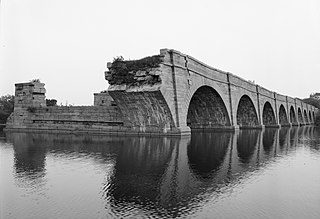
Schoharie Crossing State Historic Site, also known as Erie Canal National Historic Landmark, is a historic district that includes the ruins of the Erie Canal aqueduct over Schoharie Creek, and a 3.5-mile (5.6 km) long part of the Erie Canal, in the towns of Glen and Florida within Montgomery County, New York. It was the first part of the old canal to be designated a National Historic Landmark, prior to the designation of the entire New York State Barge Canal as a NHL in 2017.

Grant Cottage State Historic Site is an Adirondack mountain cottage on the slope of Mount McGregor in the town of Moreau, New York. Ulysses S. Grant, the 18th President of the United States, died of throat cancer at the cottage on July 23, 1885. The house was maintained as a shrine to U.S. Grant following his death by the Mount McGregor Memorial Association and a series of live-in caretakers. The building became a New York State Historic Site in 1957 and was added to the National Register of Historic Places in 1971. The Historic Site was designated a National Historic Landmark by the National Park Service in 2021.
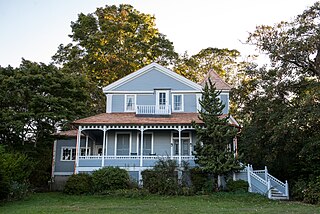
Monte Cristo Cottage was the summer home of American actor James O'Neill and his family, notably his son Eugene O'Neill. It is a National Historic Landmark located at 325 Pequot Avenue in New London, Connecticut.
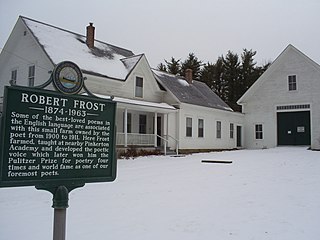
The Robert Frost Farm in Derry, New Hampshire is a two-story, clapboard, connected farm built in 1884. It was the home of poet Robert Frost from 1900 to 1911. Today it is a New Hampshire state park in use as a historic house museum. The property is listed in the National Register of Historic Places as the Robert Frost Homestead.
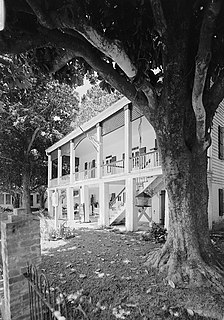
The Kate Chopin House, also known as the Bayou Folk Museum or Alexis Cloutier House, was a house in Cloutierville, Louisiana. It was the home of Kate Chopin, author of The Awakening, after her marriage.
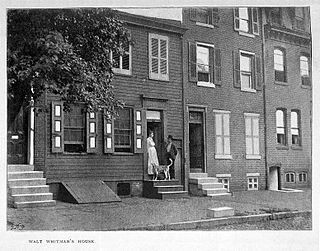
The Walt Whitman House is a historic building in Camden, New Jersey, United States, which was the last residence of American poet Walt Whitman, in his declining years before his death. It is located at 330 Dr. Martin Luther King Jr. Boulevard, known as Mickle St. during Whitman's time there.

Chichester's Inn is located along Chichester Road in a wooded section of West Hills, New York, United States. It is a rare surviving example of a 17th-century inn on Long Island, mostly unchanged from its original form, although it is now used as a house. Walt Whitman, who grew up in the area, and Theodore Roosevelt were among its past patrons. In 1985 it was added to the National Register of Historic Places.
Joseph Whitman House is a historic home located at West Hills in Suffolk County, New York. It was built about 1692 and is a 1+1⁄2-story, four-bay shingled residence with a 1+1⁄2-story two-bay south wing. Also on the property is the site of a stone fort and an early-19th-century barn and shed.
Whitman-Place House is a historic home located at West Hills in Suffolk County, New York. It was built about 1810 and is a 2+1⁄2-story, three-bay shingled residence which was greatly enlarged with a 2+1⁄2-story, three-bay south wing built in the 20th century. Also on the property is an early-19th-century barn and springhouse.





















